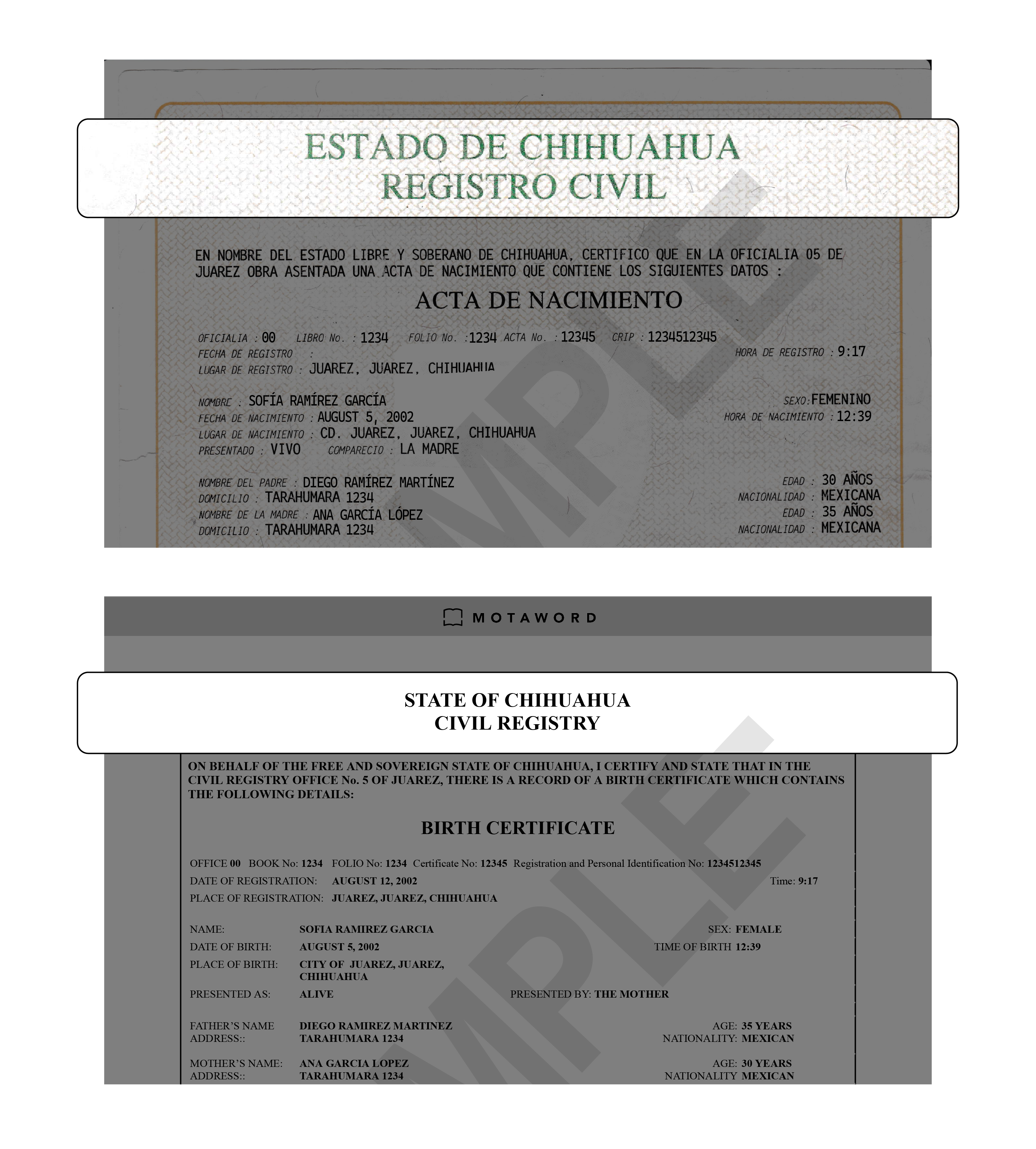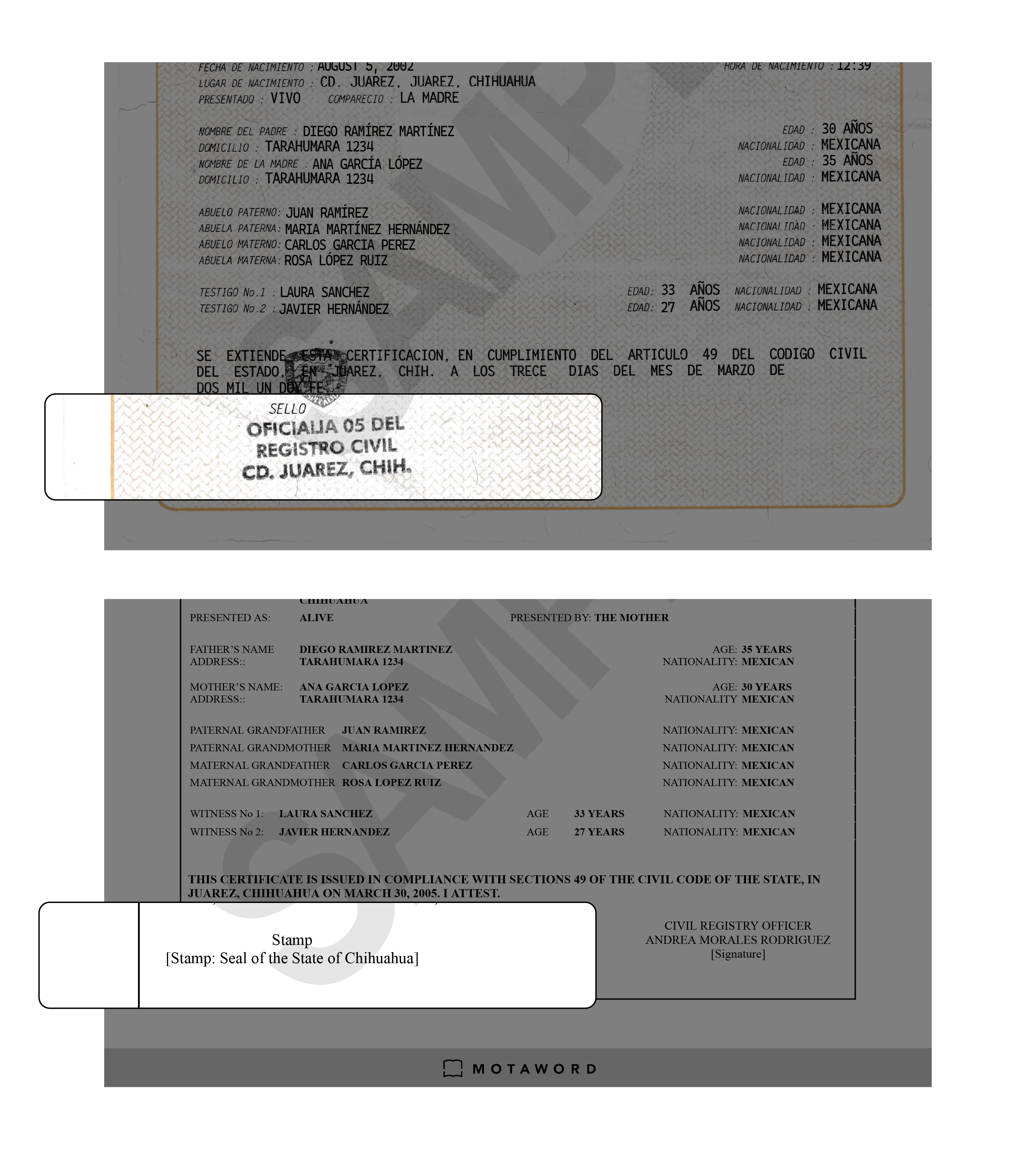Here at MotaWord, Mexican birth certificate translation is one of our top services. We offer outstanding translation services for various types of Mexican certificates, including birth, marriage, divorce, death, and graduation certificate translations.
When moving to the United States, you must translate all of your essential documents, such as your birth certificate from Mexico. In this article, we’ll walk you through the steps involved in translating a birth certificate from Mexico. We’ll also go over some of the most common mistakes translators make, how to catch them and ask for corrections, and we’ll tell you if you can handle the translation yourself, which is a complex matter. Finally, we’ll show you how to select a reliable certified translation service. Let’s get right into it!
Understanding the Mexican Birth Certificate
A typical Mexican birth certificate contains vital information such as:
- Full name of the individual
- Date and place of birth
- Names and nationalities of parents
- Details of the registration office
- Information on witnesses (if any)
All of these details must be translated or adapted to match U.S. official translation standards. There are other important aspects, such as getting a translation certificate, detailing the information of the translator, their signature, and other details that are vital for USCIS to accept the translation you’re delivering.
Certified Translation Services?
Key Points for Translation
When translating, pay close attention to the following:
Accuracy:
When translating for U.S. immigration purposes, the accuracy of names, places, and dates is paramount. Here are key points to consider:
1. Names:
-
Full Names: Kindly translate complete names without altering them. For example, "Michel Fernanda Quiroz Lopez" should stay the same. Don't abbreviate or change any portion of the name.
-
Special Characters: Names with accents or unique characters, such as the accentuation in the name "José," should be removed rather than kept. The translation would be "Jose." With that said, the names should not be altered or translated. For example, "Joseph". Although it is a proper translation of the name "José", it shouldn't be used because it is a different name.
-
Name Order: Names should remain in the same order as in the original document. The typical order of names in Mexico is first name, paternal surname, and maternal surname.
2. Locations:
-
Full Place Names: Type the birthplace's complete name almost exactly as it appears, but remove any special characters. It is more accurate to interpret "Ciudad Juarez, Juarez, Chihuahua" as "Cd. Juarez, Juarez, Chihuahua."
-
Geographic terms: Know how to translate terminology related to geography correctly. For instance, the English translation of "Estado" should be "State."
Here is an example that shows how to correctly translate geographic terms from Spanish to English in the context of a birth certificate from Mexico:
Original Spanish Term: "Estado de Chihuahua"

Breakdown of Translation:
"Estado":
Spanish Meaning: "Estado" in Spanish refers to a territorial and political division within a country, similar to a "state" in the United States. Correct English Translation: "State."
"de":
Spanish Meaning: "de" is a preposition in Spanish, typically translated as "of" in English, used to denote possession or belonging.
Correct English Translation: "of."
"Chihuahua":
Contextual Meaning: "Chihuahua" is the name of a state in Mexico. It is a proper noun and should be kept the same in both Spanish and English. Correct English Translation: "Chihuahua" (unchanged).
Complete Translated Term: "State of Chihuahua"
As an example, the English translation of the original Spanish phrase "Estado de Chihuahua" is "State of Chihuahua." In particular, for U.S. immigration purposes, this precise translation guarantees that the geographic terminology complies with the conventions understood in English-speaking contexts.
Not Using Any Abbreviations: Use just those acronyms that are included in the original document.
Here's an example from reality to show how abbreviations should be handled when translating a Mexican birth certificate:

Original Spanish Abbreviation: "Cd. Juarez"
Breakdown of Translation:
"Cd.": Spanish Abbreviation: "Cd." is an abbreviation for "Ciudad," which means "city" in English.
Correct English Translation: If "Cd." is used in the original document, it should be translated to "City" to reflect the full meaning of the abbreviation.
"Juarez":
Contextual Meaning: "Juarez" is the name of a city in Mexico, specifically a city in the state of Chihuahua. It is a proper noun and should remain the same in both Spanish and English.
Correct English Translation: "Juarez" (without accents).
Complete Translated Term: "City of Juarez"
In this case, "City of Juarez" is the accurate translation into English of the original Spanish abbreviation "Cd. Juarez." By expanding the abbreviation to its full English form, this translation preserves the geographical reference while also offering clarity.
3. Dates:
-
Exact Date Format: Translate dates, maintaining the original format. “16 de Julio de 1998” should be translated to “July 16, 1998.”
-
Month Names: Translate the names of the months accurately. Avoid numerical representations unless the original document uses them.
-
Year Translation: Translate the full year. Do not shorten the year (e.g., '98) if the original document states “1998.”
While these guidelines offer an overview for accuracy, it is always advisable to consult with a certified translator who specializes in immigration documents or to refer to the particular requirements of the U.S. Citizenship and Immigration Services (USCIS) to ensure compliance with all relevant standards.

Sample Our Birth CertificateTranslations
Explore our translation skills with a free Mexican Birth Certificate translation sample.
DOWNLOADFormat and Layout:
To comply with U.S. immigration authorities' requirements, the translated Mexican birth certificate's format and layout are essential elements that need to be carefully duplicated. Here's a thorough explanation:
Structure of Document:
- Layout Consistency: The translated document's layout needs to match that of the source. This entails keeping the text, paragraphs, sections, and margins in the same order. Placement and Alignment: Maintain the same line-and paragraph-spacing and alignment (left, right, and center) as the original document.
Authentic Logos and Seals:
- Seal Replication: Official seals and logos cannot be replicated in a translated document, but their locations must be noted. For instance, you could write "Logo placed here" or "Official Seal here" in the appropriate spaces.
An explanation of seals: Give a succinct English description of the seal or logo, such as "National Emblem of Mexico" or "Seal of the State of Chihuahua."

Signatures:
-
Signature Placement: Identify the locations of the signatures in the original document. In the precise spots, you can use placeholders such as "Signature of Registrar" or "Signature of Parent."
-
Title Translation: Convert signatures with titles like "Registrador Civil" to "Civil Registrar."
Headings and Titles of Documents:
-
Precise Translation: Translate headings and titles precisely, preserving the font style and size to match the emphasis in the source.
-
Placement: Make sure that the headings and titles are positioned in the same places as they were in the original document.
Notes and annotations:
-
Annotations: Any footnotes or annotations in the source document must be translated and inserted in the same location in the translated version.
-
Formatting of Annotations: Annotations must adhere to the original's formatting guidelines, including using italics or underlining.
The Value of Precise Format and Layout
-
Professional Presentation: A translation is seen as more credible and professional if it faithfully replicates the original document's structure and style.
-
Ease of Review: When the format and layout of the translated document are consistent, immigration officials will find it easier to compare and validate it against the original.
-
Legal Compliance: Correct formatting lowers the possibility of a document being rejected by guaranteeing adherence to the requirements set forth by US immigration authorities.
Note:
Although these guidelines are extensive, to make sure your translated birth certificate meets all requirements, always refer to the particular guidelines provided by the U.S. Citizenship and Immigration Services (USCIS) or consult with a certified translator or agency experienced in translating documents for U.S. immigration.
Legal Terms:
It takes exact knowledge of legal systems and terminology to translate legal terms and titles from Mexican civil documentation into their equivalents in the United States. Here are some important things to think about:
Translation of Legal Terms and Titles
"Registrador Civil" (Civil Registrar):
-
Spanish Context: The official responsible for recording vital statistics, such as births, marriages, and deaths.
-
U.S. Equivalent: "Registrar of Vital Records" or simply "Registrar."
"Acta de Nacimiento" (Birth Certificate):
-
Spanish Context: An official document recording the birth of a person.
-
U.S. Equivalent: "Birth Certificate."
"Número de Acta" (Act Number):
-
Spanish Context: The unique identifier for the birth record.
-
U.S. Equivalent: "Record Number" or "Certificate Number."
"Municipio" (Municipality):
-
Spanish Context: Refers to a local government area, often smaller than a state.
-
U.S. Equivalent: "Municipality" or "County" (depending on context).
"Entidad Federativa" (Federal Entity):
-
Spanish Context: Refers to states within Mexico.
-
U.S. Equivalent: "State."
"Curp" (Clave Única de Registro de Población):
-
Spanish Context: A unique identity code for citizens and residents of Mexico.
-
U.S. Equivalent: "Unique Population Registry Code" or "Personal ID Number."
"Fecha de Registro" (Date of Registration):
-
Spanish Context: The date when the event (birth, marriage, etc.) was officially registered.
-
U.S. Equivalent: "Date of Registration."
"Nombre de los Padres" (Names of the Parents):
-
Spanish Context: Names of the individual's parents.
-
U.S. Equivalent: "Names of Parents."
The significance of Accurate Translation
-
Legal Validity: Accurate translation of legal jargon guarantees the document's acceptance and comprehension within the American legal system.
-
Clarity: When officials and authorities are reviewing a document, accurate translations help them understand it clearly.
-
Consistency: It helps to preserve consistency amongst different legal procedures and official documents.
To guarantee that the translation is both linguistically correct and legally appropriate for the context of the United States, it is essential to comprehend the context and legal ramifications of each term when translating it. It is advisable to consult a legal expert or a certified translator with experience translating legal documents when dealing with specialized terms or when in doubt.
Can You Translate Documents for USCIS Yourself?
The short answer is “you can, but you shouldn’t”. Although it is technically possible for you to translate documents yourself, doing so is not recommended for official immigration purposes. The person to whom the document relates cannot perform a certified translation, which is required by the United States Citizenship and Immigration Services (USCIS) and other U.S. entities. There are other requirements, like understanding both languages, having experience with document translation, and being able to certify accuracy and completeness, among other things. To translate a marriage certificate from Spanish to English, you must have very specific knowledge.
However, this seems to be a complex matter. Whenever you search online using Google, searching, for example, "how to translate a Mexican birth certificate to English", you’ll find forum comments detailing how some people managed their translations. It’s important to note that information in some forums, like Reddit, is not reliable for legal and other official purposes. Often, we find customers being misled to believe that they can translate their documents when it’s not the case. To achieve the best possible outcome, please rely on any certified translation provider that meets the requirements, whether it’s an individual translator or a translation agency such as MotaWord.
Choosing the Right Certified Translation Provider for Your Mexican Birth Certificate
Take into account the following factors when choosing a translation service:
-
Certification: Verify that the service offers USCIS-acceptable certified translations.
-
Experience: Select service providers with official immigration document translation experience.
-
Accuracy and Reliability: Seek out endorsements or reviews that attest to their accuracy and dependability.
When Is a Certified Translation Needed?
A certified translation of your Mexican birth certificate is required for several immigration-related procedures, such as:
-
Visa applications
-
Green card applications
-
Naturalization processes
Accuracy and meticulous attention to detail are required when translating your Mexican birth certificate for immigration purposes in the United States. Even though it might seem difficult, selecting the best certified translation service can make things easier and guarantee that your trip to the United States goes as smoothly as possible.
Certified Translation Services?
Frequently Asked Questions (FAQs)
1. What is a Mexican birth certificate translation template?
A Mexican birth certificate translation template is a pre-designed format that helps guide the translation process of a Mexican birth certificate into English. While templates can be helpful, it's important to use a certified translator to ensure the accuracy and validity of the translation. It’s also worth mentioning that, even though you can find templates online, translations must match the original document’s layout. In short, using a template with a different layout might not be a good idea.
2. Why do I need a certified Mexican birth certificate translation?
A Mexican birth certificate translation is essential for official processes, including visa applications, green card applications, and naturalization procedures. For other unofficial matters, it’s usually not necessary to certify translations. On the other hand, you might need certified or even notarized translations for other official purposes. That’s why asking the receiving party beforehand if that’s a requirement is a good idea.
3. Can I get a Mexican birth certificate translation sample before I hire a service?
Yes, many professional translation services, including MotaWord, provide a Mexican birth certificate translation sample for you to review before committing to a full translation. In this article, you’ll find a quick form you can fill out to receive one. You can also reach out through our live chat, and we’ll provide one as soon as possible.
4. Can I use an online Mexican birth certificate translation service for my USCIS application?
Absolutely! Here at MotaWord, we’ve helped thousands of USCIS applicants deliver high-quality translations for their immigration processes, and our translations are always accepted. Reach out or go to our quote page to get a quick and free cost estimate for your specific documents!
Professional Mexican Birth Certificate Translation is a Necessity
Translating Mexican birth certificates for US immigration purposes is a critical step in the immigration process that requires meticulous attention to detail and a thorough understanding of both Mexican and US legal requirements. Ensuring that names, dates, and places are translated accurately and consistently can have a significant impact on the success of your immigration application.
Working with a certified translation service that specialises in immigration documents is essential. Such services not only guarantee accuracy and compliance with USCIS standards but also provide peace of mind that your documents will be accepted without issue. The process involves not only linguistic translation but also cultural and legal adaptation, which can be complex and nuanced.
Remember, self-translation is not recommended for official immigration documents due to the high risk of error and possible rejection by immigration authorities. Instead, opt for professional translation services such as those offered by MotaWord. We provide certified translations tailored to the specific needs of US immigration. By taking the time to ensure that your Mexican birth certificate is accurately and professionally translated, you can avoid unnecessary delays and complications in your immigration journey.
/f/84976/2006x2006/5f326a2e9c/translating-mexican-birth-certificates-for-us-immigration-purposes-2.png)




